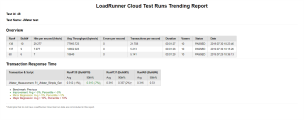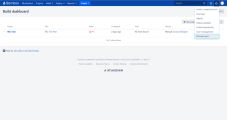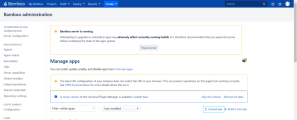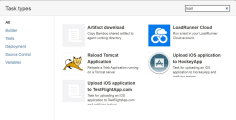CI plugins
The LoadRunner Cloud plugins for continuous integration enable you to trigger a LoadRunner Cloud test as a build step and present the results in the CI server's user interface.
Note: This topic contains a number of instances where you need to enter the LRC server URL. You can get the URL by coping it from the address bar of the browser in which you opened LoadRunner Cloud. For example, if the URL in the address bar of the browser is https://loadrunner-cloud.saas.microfocus.com/home/?TENANTID=208294383&projectId=1, copy the address https://loadrunner-cloud.saas.microfocus.com.
Use the Jenkins plugin
We recommend that you always use the latest version of the plugin. Older versions of the plugin (versions 4.8.43 or earlier) have been deprecated.
To install the latest Jenkins plugin:
Download and install the latest LoadRunner Cloud Jenkins Plugin which is available on the official Jenkins plugins website.
To upgrade the Jenkins plugin from an older (deprecated) version:
Uninstall the old plugin, restart Jenkins, and then install the new Jenkins plugin.
Note: If you are upgrading from an older (deprecated version), previous configuration and historical data is not saved.
To use the deprecated Jenkins plugin:
To install and work with an old version of the Jenkins plugin (version 4.8.43 or earlier), do the following:
-
Download the old LoadRunner Cloud Jenkins Plugin.
-
To upload the plugin to your Jenkins server, navigate to Jenkins in your browser, and select Manage Jenkins > Manage Plugins > Advanced from the Jenkins menu. From the Upload Plugin section, upload the “JenkinsStormPlugin.hpi” that you downloaded in the previous step.
-
Restart your Jenkins server.
- From the Jenkins menu, select Manage Jenkins > Configure System.
-
Locate the LoadRunner Cloud section and enter the LoadRunner Cloud URL (see note in CI plugins for details).
-
To authenticate with a username and password, enter the credentials.
Setting Description Username
Your username to log into LoadRunner Cloud.
Example:
loadrunner.cloud@microfocus.comPassword Your password to log into LoadRunner Cloud. -
To authenticate with an access key, select Use OAuth token. Paste in the Client ID, Client Secret, and Tenant ID values as provided by your administrator.
-
If you require Jenkins to connect to LoadRunner Cloud through a proxy server, select Use proxy connecting to LoadRunner Cloud server and configure the following:
Setting Description Proxy Host The proxy server host name. Proxy Port The proxy server port number. Proxy Username The username to log into the proxy server. Proxy Password The password to log into the proxy server. These settings are only used for connections between Jenkins and LoadRunner Cloud—they do not affect other areas of Jenkins or your global proxy settings.
You can create two types of projects—Free-style or Pipeline.
Free-style project
- From the Jenkins menu, select New item.
- Select Build a free-style software project.
- Click OK.
- Select Add build step > LoadRunner Cloud run loadtest.
-
Enter the following:
Argument Description tenant Your tenant ID, specified in your LoadRunner Cloud URL.
Example:
https://loadrunner-cloud.saas.microfocus.com/home/?TENANTID=354274891testId The ID for the test.
To see the test ID, open the test in the Load tests tab and click Test settings. The test ID is displayed in the upper-right side of the page.
Tip: To build a more flexible job, you can configure a parameter named LRC_TEST_ID with the Jenkin's String Parameter feature. After you configure the parameter, the plugin uses the parameter value instead of the “testId” entered in Build > LoadRunner Cloud run loadtest.
projectId Your projectId, specified in your LoadRunner Cloud URL.
Example:
https://loadrunner-cloud.saas.microfocus.com/home/?TENANTID=354274891&projectId=1Tip: To build a more flexible job, you can configure a parameter named LRC_PROJECT_ID with the Jenkin's String Parameter feature. After you configure the parameter, the plugin uses the parameter value instead of the “projectId” entered in Build > LoadRunner Cloud run loadtest.
SendEmail Select the check box to be notified when the test ends.
Note: The string parameters LRC_TEST_ID and LRC_PROJECT_ID are not supported for pipeline style jobs.
Pipeline project
The Jenkins plugin supports using Jenkins Pipeline. By installing the Pipeline plugin, you can create Pipeline type projects and write Pipeline scripts to invoke supported steps (start a test run and generate a trending report).
The following is an example script to start a test run:
pipeline {
agent any
stages {
stage('SRL') {
steps {
srlRunTest projectID: '1', sendEmail: false, tenant: '388459696', testID: '6'
}
}
}
}
You can view the detailed step description in Jenkins by navigating to Pipeline Syntax > Snippet Generator > Steps.
You can configure Jenkins to create a report that shows the trends for the last 5-10 runs of the load test configured in the job.
Configure the Trending report for a free-style project
- In Jenkins, select your LRC job and then select Configure from the menu.
- Select the Post-build Actions tab, and then click Add post-build action.
-
From the drop down menu, select Generate LoadRunner Cloud Trending and enter the following:
Common Number of Runs The number of last successful runs to include in the report. The valid range is 5-10. Benchmark Enter a specific run ID to use as a benchmark, or leave blank to compare a run to the previous run.
Note: If you change the benchmark run ID, only those load tests that run after the change are compared to the new benchmark. Load tests that ran before the change show their original comparison.
Thresholds: TRT (Avg)
Enter a positive integer between 0-100
Improvement The percentage decrease in average transaction response time considered to be an improvement in performance. Minor Regression The percentage increase in average transaction response time considered to be a minor regression in performance. Major Regression The percentage increase in average transaction response time considered to be a major regression in performance. Thresholds: TRT (Percentile)
Enter a positive integer between 0-100
Improvement The percentage decrease in the 90th percentile maximum transaction response time considered to be an improvement in performance. Minor Regression The percentage increase in the 90th percentile maximum transaction response time considered to be a minor regression in performance. Major Regression The percentage increase in the 90th percentile maximum transaction response time considered to be a major regression in performance.
Configure the Trending report for a Pipeline project
Add the command to generate a Trending report to the script.
The following is an example script to both start a test run and generate a trending report:
pipeline {
agent any
stages {
stage('SRL') {
steps {
srlRunTest projectID: '1', sendEmail: false, tenant: '388459696', testID: '6'
srlGetTrendingReport benchmark: 0, runsCount: 5, trtAvgThresholdImprovement: 5,trtAvgThresholdMajorRegression: 10, trtAvgThresholdMinorRegression: 5, trtPercentileThresholdImprovement: 5, trtPercentileThresholdMajorRegression: 10, trtPercentileThresholdMinorRegression: 5
}
}
}
}
From the Jenkins dashboard, select the test and click Build Now.
When the build completes, click Console Output on the dashboard to view the log.
The JenkinsStormPlugin.hpi generates the following files in the workspace folder after the build completes:
| File | Description |
|---|---|
| srl_report_<tenant id>-<run id>.xml | A Junit XML file containing basic information about the test, such as name, status, and duration. |
| srl_report_<tenant id>-<run id>.csv | A CSV file containing detailed test run results with metrics such as Vuser count and error count. |
| srl_report_trans-<tenant id>-<run id>.csv | A CSV file containing detailed statistics on each transaction in the test run. |
If you configured Jenkins to create a LoadRunner Cloud Trend report, from the Jenkins dashboard click LoadRunner Cloud Trend to view the report.
The report is displayed, showing test run metrics for the configured number of last successful runs and the status (improvement, minor regression, major regression) according to the thresholds you set.
Note: If you terminate a Jenkins job that includes a running load test, the plugin attempts to stop the load test and download any results files (such as .xml or .csv files), if they are available. This attempt may fail in the event of network problems, or if Jenkins ends the job before the plugin can stop the load test.
Use the Bamboo plugin
To use the Bamboo plugin, carry out the following steps.
Install and deploy the plugin
| Action | How to |
|---|---|
| Verify that your Bamboo server is up and running | Refer to the Bamboo documentation. |
| Download the plugin | From LoadRunner Cloud banner > Tools and Integrations > Plugins, download the LoadRunner Cloud Bamboo plugin. |
| Install the plugin | |
| Configure LoadRunner Cloud server connection details |
In Bamboo administration, configure the following details for connecting to LoadRunner Cloud:
Click Save & Test to test the connection using the credentials that you provided. |
Add a task
Do the following to add a LoadRunner Cloud task to your job in Bamboo:
Add the following task details:
| Argument | Description |
|---|---|
| Task description | Give the task a description. |
| Disable the task | If selected, the task does not run during the parent job. |
| Tenant |
Your tenant ID, specified in your LoadRunner Cloud URL. Example: |
| Project ID |
Your ID specified in your LoadRunner Cloud URL. Example: |
| Test ID |
The ID for the test. To see the test ID, open the test in the Load tests tab and click Test settings. The test ID is displayed in the upper-right side of the page. |
| Send Email | Select this check box if you want to receive a notification email after the test run is finished. |
Use the Azure DevOps plugin
Use the Azure DevOps Server (also known as TFS, Team Foundation Server) and Visual Studio Team Services (VSTS, also known as Azure DevOps) plugin to include a LoadRunner Cloud test as part of a build script. tom
-
Download the LoadRunner Cloud extension for Azure DevOps.
-
Install the extension for Azure DevOps. For details, refer to the Azure DevOps extension installation help.
-
Create a service endpoint. For details, refer to the Azure manage service connections help.
When creating the service endpoint, configure the following parameters for LoadRunner Cloud:
Name Description Server URL URL to connect to the LoadRunner Cloud server (see note in CI plugins for details).
Authentication -
For username/password authentication, enter the following:
-
User Name. Your user name to log on to LoadRunner Cloud.
-
Password. Your password to log on to LoadRunner Cloud.
-
- For OAuth authentication, paste your Client ID in the User Name box, and your Client Secret in the Password box.
Proxy URL Add your local proxy in the format http(s)://(host):(port#) or leave empty if you are not using a local proxy. Proxy Username If using a proxy that requires credentials, enter the user name. Proxy Password If using a proxy that requires credentials, enter the password. -
-
Add a task to the build. For details, refer to Azure tasks help.
When creating the task, configure the following parameters for LoadRunner Cloud:
Name Description LoadRunner Cloud Service Endpoint Select the service endpoint you created above for your LoadRunner Cloud server. Tenant ID Your tenant ID, specified in your LoadRunner Cloud URL.
Example:
https://loadrunner-cloud.saas.microfocus.com/home/?TENANTID=354274891Project ID Your project ID, specified in your LoadRunner Cloud URL.
Example:
https://loadrunner-cloud.saas.microfocus.com/home/?TENANTID=354274891&projectId=1Test ID The ID for the test.
To see the test ID, open the test in the Load tests tab and click Test settings. The test ID is displayed in the upper-right side of the page.
Send e-mail to the preset address Select this check box if you want to receive a notification email to a preset address after the test run is finished. Run Test in Detached Mode Select this check box if you don't want the task to wait for the load test run to finish. This disables the reporting of test run results. -
For earlier versions of the Azure DevOps server, you may need to enable the Allow scripts to access the OAuth token option before running the task.
-
When the task has finished, you can view an artifact published on the Summary tab and a brief report on the LoadRunner Cloud tab.
-
When finished, a variable called LRC_RUN_ID is available in the extension. This variable stores the ID of the run started by the task. You can use this variable in later steps in the same pipeline to query LoadRunner Cloud public APIs for additional metrics (after the run finishes and such metrics are available).
To use the LRC_RUN_ID variable in the pipeline:
Pipeline Job Steps Classic Same job -
Set a reference name for the LoadRunner Cloud test task.
-
Refer to the variable in the format $(<ReferenceName>.<VariableName>).
For example, if you set a reference name of LRC, refer to the variable by using $(LRC.LRC_RUN_ID).
YAML Same job -
Set a name for the LoadRunner Cloud test task. For example, name:LRC.
-
Refer to the variable in the format $(<ReferenceName>.<VariableName>).
For example, if you set a name of LRC, refer to the variable using $(LRC.LRC_RUN_ID).
YAML Different job
Note: To use the variable in a different job, you must use the YAML pipeline.
-
Set a name for the LoadRunner Cloud test task. For example, in the runLRC job, set name:LRC.
-
In the jobs in different tasks, set dependsOn to the job name in which you defined the name for theLoadRunner Cloud test task in the above step. For example, dependsOn runLRC.
-
Map the variable to the current job. For example, runIdFrom_LRC: $[ dependencies.runLRC.outputs['LRC.LRC_RUN_ID'] ].
-
You can now refer to the variable using the mapping defined in the above step. For example, $(runIdFrom_LRC)
For more information, see Use output variables from tasks in the Azure Devops documentation.
-
Use GitHub Actions
LoadRunner Cloud provides a GitHub Action to enable you to trigger a load test and collect reports as part of a workflow. You can include the action as a step in your workflow YAML file and provide the necessary input parameters. For example:
```
- name: start a load test run
uses: MicroFocus/lrc-gh-action@v1
env:
...
with:
...
```For more information and examples, see LoadRunner Cloud GitHub Action.
For general information on GitHub Actions, refer to the GitHub Actions documentation.
 See also:
See also:


















